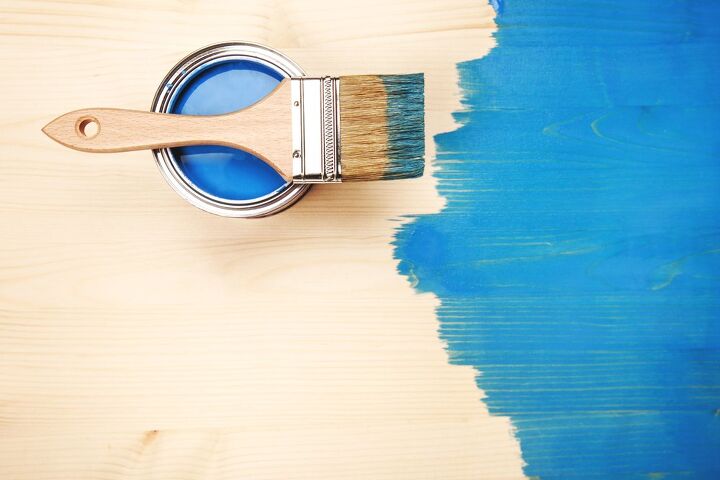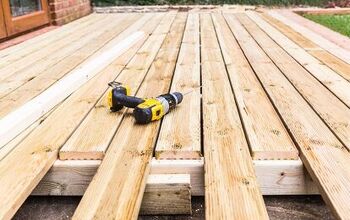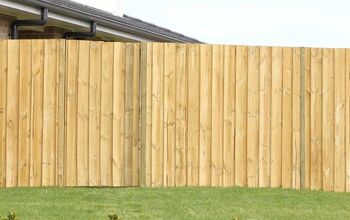Can You Paint Pressure Treated Wood?

If you recently put up a wooden fence or built a deck, the odds are you used pressure treated wood to do so. Pressure treated wood is highly durable and long-lasting wood. Its resistance to outside elements makes it the ideal choice for those building something with wood outdoors. As you look at your freshly built wooden structure, you might get the urge to paint it. But can you paint pressure treated wood?
You can paint pressure treated wood, but you need to make sure it has fully dried before you paint it. Pressure treated wood can take up to four months to dry, depending on several factors like climate and how it was stored. You can also purchase kiln-dried pressure treated wood if you can’t wait that long. Make sure you clean, dry and prime the wood before painting it.
It is certainly possible, and often preferred, to paint pressure treated wood. It can give it a great pop of color and professional finish. The wood might even last even longer. But before you go paint shopping you should understand the do’s and don’ts when it comes to painting pressure treated wood. In order to fully grasp these concepts, you first need to understand exactly what pressure treated wood is, and how it is made.
Pressure Treated Wood Explained
Pressure treated wood is wood that goes through a level step process that involves high pressure and chemicals. Wood is placed into large containers, and the containers are then filled with a chemical solution. Once closed, the container is vacuum sealed and then placed under high pressure. This high pressure is what forces the chemical solution deep inside the wood.
Once the wood is pressurized, these chemicals live within this wood for its lifespan. There are different types of pressurized wood, but the goal is always to help it withstand different outside forces that eat away at wood. Pressurized wood is great at fighting off pests, rot, fungus and other natural elements that eat away and destroy wood. Some of the most important lasting benefits of pressure treated wood are listed below.
- More Durable In Natural Elements Than Untreated Wood
- Less Susceptible To Rot And Fungus
- Has A Longer Lifespan Once Treated
- Resistant To Insects And Other Pests
How Long To Wait Before Pressure Treated Wood Is Dry
Now that you understand you need to wait until pressure treated wood is fully dry before painting it, you likely want to know exactly how long that takes. Well, it takes a while. In fact, it can take 3 to 4 months for pressure treated wood to fully dry to a point where it is safe to paint. The drying process can take even longer, or less time. It all depends on four main factors, which we have listed below.
Factors That Impact How Quickly Pressure Treated Wood Dries
1. Size Of Wood
The size, especially thickness, will determine how long it takes pleasure treated wood to dry. The thicker the piece of wood, the longer it will take to dry. Then fence pieces, on the other hand, tend to dry faster.
2. Type Of Wood
The type of wood also plays a role in how quickly your pressurized wood takes to dry. As a general rule, softer woods tend to dry faster than harder woods. When wood is pressurized, even the soft wood hardens up a bit and takes a long time to dry. But if you have pressure treated wood that was already hard to begin with, plan on allowing extra drying time.
3. Humidity And Climate
The humidity level where the wood is drying also plays a major role. If the wood is drying somewhere with lots of rain and humidity it can take much longer than normal to dry. Do your best to wait until a dry time of year before you plan to paint pressure treated wood. Or better yet, allow it to dry in a climate-controlled space before you install it outdoors.
4. Sun Versus Shade
Wood that dries in an open sunny space will dry faster, pressure treated or not. Well ventilated space is important. Sun is sometimes helpful, but too much sun can cause warping and damage, so be careful. On the other hand, try not to keep your wood in a dark dank spot while it dries. It will only prolong the drying process.
Painting Versus Staining Pressure Treated Wood
You might be on the fence as to whether you should paint or stain your pressure treated wood. The good news is, you can definitely do either one. As you now know, you need to make sure the wood is completely dry on the outside and inside before painting pressurized wood.
While you should wait for pressurized wood to completely dry before staining it as well, you might not have to be quite as patient. Paint sits on top of wood and acts as a shield. This is the main reason you need to ensure it is not wet underneath, as it can cause moisture bubbles and issues. Because stain soaks into wood and allows it to breathe a bit, you only have to wait until the wood is completely dry to the touch. Still, for best results it’s always best to wait until pressure treated wood is fully dry.
Steps To Successfully Painting Pressure Treated Wood
Step One: Use A Moisture Meter And Test Surface
The best way to know when your pressure treated wood is dry enough to paint is by testing it with a moisture meter. If the wood you are painting is for the outdoors, like a deck, the wood should test a 15% or lower. Indoor wood should test even lower, so aim for 12% or less.
You should also do the surface test. It is very simple. Just pour a bit of water on the surface of the wood in question. If the water beads up, then it is not dry. If the water soaks in, it is dry.
Step Two: Paint On A Warm, Dry Day
Look at your calendar, and then look at the weather. Make sure you are painting on dry days. Warm weather is better, as it promotes paint and primer drying. You should avoid painting in cold weather.
Keep in mind this project can take a few days. So do your best to find a time where there are several days with relatively low humidity and pleasant weather.
Step Three: Scrub And Dry The Surface
Before you prime or paint the pressure treated wood, you need to clean it. If you were to paint without thoroughly cleaning the wood then all the dirt particles would get mixed up with the paint. Also, clean surfaces are much easier for paint to adhere to. This allows for consistent and professional-looking coverage.
Tip: Elbow grease works better than a pressure washer. Hand scrubbing is safe, while a pressure washer can damage the wood, especially on a higher setting.
Step Four: Patch Up Cracks In Advance
As you clean the wood, look out for any small or large cracks. These should be filled with epoxy resin or something similar. Then you should sand the area down and wipe it clean once more.
You should also patch up any noticeable imperfections. This is important for several reasons. For one, it lends itself to a smooth finish and better final product. Also, crack and imperfections, when left untreated, will grow. This can lead to a weakening of the wood, which is exactly what you are trying to avoid.
Step Five: Don’t Forget A Primer Layer
It is crucial to start any wood painting project with a primer layer. Skipping this step can lead to uneven and patchy results. It can even mean that the paint can chip or peel off much quicker.
Primer is like glue and also a fresh surface for the paint. It makes sure it will stay on, even when the surface is less ideal (like wood, for example). When selecting a primer, you should match the paint type with the primer type. So if you have a latex-based paint, find a quality latex-based primer that is designed to work well on wood.
Step Six: Paint The Pressure Treated Wood
Finally you are ready to paint your pressure treated wood once your primer layer fully dries. Check the primer can to see how long you should wait, and also make sure it is dry to the touch before proceeding with a paint layer.
Brush on the first layer of paint with thin and even paint layers. In general, you should use two coats of paint, waiting for each layer to dry.
Step Seven: Inspect And Perform Touch Ups As Needed
Once you finish painting your two layers (or more), allow the paint plenty of time to dry and cure. Once this is complete, review the surfaces and see if the pressure treated wood needs any touch ups.
Summing Up When You Can Paint Pressure Treated Wood
If you are wondering if it is possible to paint pressure treated wood, the answer is, yes you can! Just because wood has gone through the pressure treating process does not make it unpaintable. However, you need to make sure the wood has completely dried before painting it. Pressure treated wood can take between three and four months to dry. If you are in more of a rush to paint, look for pressure treated and kiln-dried wood.

Tom Gaffey is an expert writer who currently resides in Washington D.C. Tom has a passion for real estate and home improvement writing, as well as travel and lifestyle writing. He lived the last twelve years in Hawaii where he worked closely with luxury resorts and event planners, mastering his knowledge of aesthetics and luxury products. This is where he found his passion for home improvement and a keen interest in DIY projects. Currently, Tom resides in Washington D.C, and also working on his debut fiction novel.
More by Tom Gaffey



























